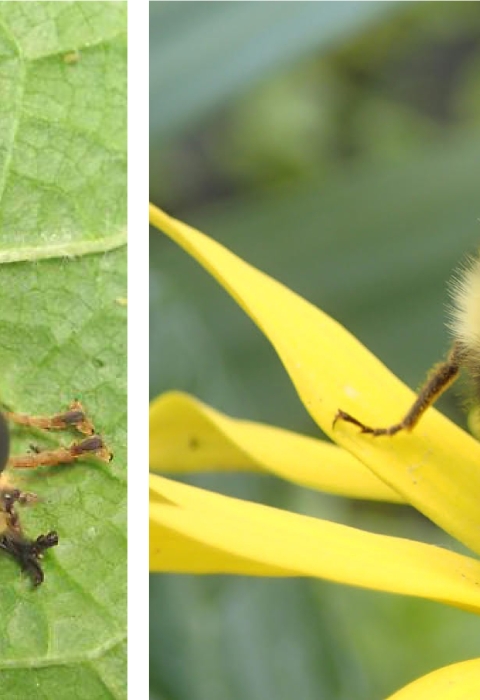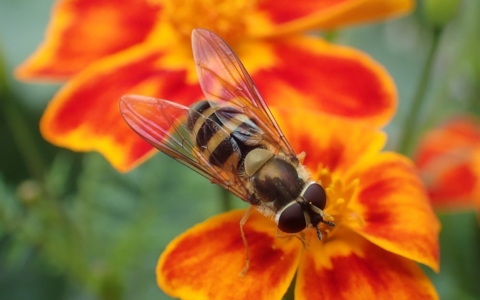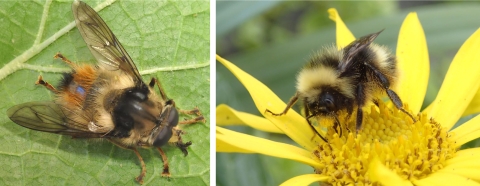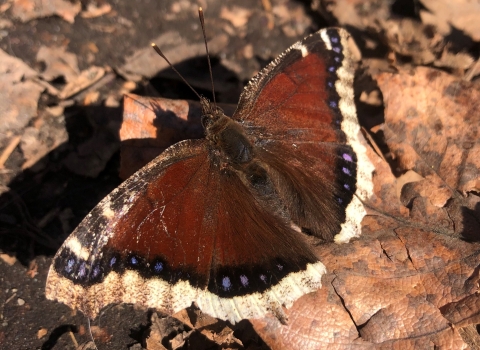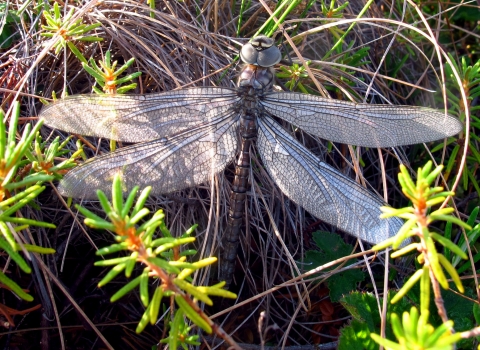Blueberries. Fireweed. Lupines. Forget-Me-Nots. Pollinators are an essential link in the reproductive success of many of Alaska’s flowering plants. We usually think of bees or bumblebees (maybe even bats or birds) when we think of pollinators, but let’s not forget the flies!
The Flower Flies
There are nearly 900 species of flower flies in North America, with roughly 200 species in Alaska (they’re also known as syrphid or “hover” flies). Adult flower flies feed on pollen and nectar. As they move from plant to plant, they serve as unintentional pollinators — pollen grains hitch a ride on their hairs to other receptive flowers.
Mimicry
Flower flies are pretty conspicuous feeding on open flowers, making them an easy target for predators. They’ve evolved a clever strategy, though: they mimic the appearance of bees and wasps to trick potential predators into thinking they can sting (they can’t).
Flower Flies Vs. Bees
Like bees, flower flies feed on nectar and pollen. Many are pretty hairy and can carry pollen and nectar on their bodies. Bees can carry even bigger loads of pollen on their legs or bellies where they have long hair. Interestingly, some bees aren’t hairy at all (like little masked bees) and will swallow pollen and store it in their crop.
Movement
Flower flies are also known as hover flies because of the characteristic way they float in the air above flowers. Comparatively, bumble bees are much more direct in their mission to collect pollen and nectar from flowers.
Tongue size
Shorter tongued species (most flower flies) favor open flowers like Asteraceae (daisy family) and other open flowers like Potentilla or Rosa (roses), while long-tongued bumble bees are often observed on deeper flowers such as Mertensia or Hedysarum.
Parental Care
A big difference between flies and bees is parental care.
Unlike bee larvae that develop in nests built and provisioned with food by their mother, flower fly larvae are independent and free-living. Flower fly larvae eat a wide variety of food, including live and decaying plants, tree sap, fungi, and small juicy bugs like aphids.
Some are even more specialized. One group of flower fly has aquatic larvae called rat-tailed maggots. It’s not the best name for making friends but who wouldn’t want their own snorkel to breathe air? This allows these larvae to survive in oxygen-poor pools filled with tasty decaying organic matter.
Because flies do not take care of their larvae, they do not need to put time into collecting pollen to feed their young, like bees do.
Cold Weather Hardiness
The diversity of flower flies in Alaska is about double that of bees. While bumble bees are well-adapted to cold, harsh climates, most other bee groups are far more diverse in dry, warm regions. Many species of flower flies thrive in the harsh conditions that Alaska has to offer.
The Bottom Line
Abundant and diverse native pollinator communities are essential for maintaining healthy, functioning wild ecosystems in Alaska. Pollinators are at risk from habitat loss and alternation, invasive pollinators and plant species, parasites and pathogens, pesticides, and climate change climate change
Climate change includes both global warming driven by human-induced emissions of greenhouse gases and the resulting large-scale shifts in weather patterns. Though there have been previous periods of climatic change, since the mid-20th century humans have had an unprecedented impact on Earth's climate system and caused change on a global scale.
Learn more about climate change . If you want to help pollinators here are some easy ways:
- Plant native flowers. Choose varieties of colors, shapes and sizes.
- Use flower combinations that result in blooms throughout the growing season so pollinators have a diverse/steady food source
- Learn more about invasive plant species in your area and volunteer for a local weed pull event.
- If you have pests eating the vegetables in your garden, consider natural pesticides. Did you know that nasturtiums (a colorful, edible flower) will repel many unwanted insects? Avoid chemical pesticides which can have unintended effects on pollinator species.
- Put that fly swatter down.
In Alaska we are shared stewards of world-renowned natural resources and our nation’s last true wild places. Our hope is that each generation has the opportunity to live with, live from, discover and enjoy the wildness of this awe-inspiring land and the people who love and depend on it.
